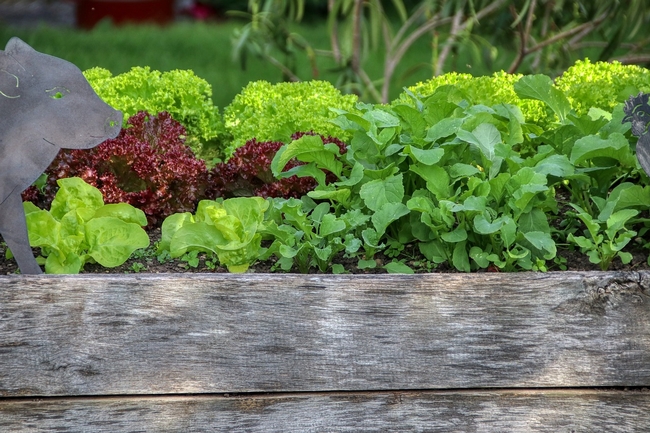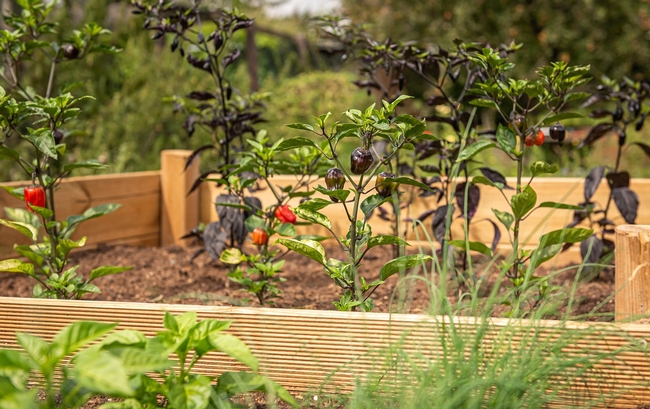Sometimes I think I should write a book called Gardening for Geezers. For those of us of a certain age, the idea of creeping about on all fours, even equipped with kneepads, is not a felicitous prospect. Some of us even need canes or wheelchairs. This is one of the reasons that raised garden beds are popular now.
There are other reasons to consider gardening in raised beds. You can position them where they get the desired shade or sun exposure. You can tailor the soil to the crop. You can avoid compacting the soil because you aren't walking on it, and you can treat the beds as a landscape feature.
Raised beds extend your growing season because the soil warms up faster in spring. They also protect your plants as pets and children aren't likely to run around in them.
I know some people who bought a house with a paved backyard. To call that yard austere was an understatement, but they didn't have the wherewithal to pull up the concrete. Instead, they installed 2-foot-deep wooden rectangles, filled them with compost from the garbage company and created an attractive garden that supplies them with vegetables year-round. They also avoided the digging that can be so hard on aging backs.
Raised beds come in many types of material. Galvanized metal horse troughs are particularly popular now. (You will need to drill drainage holes.) I have one raised bed that is 30 years old and made from salvaged railroad ties.
I have seen raised-bed garden borders made from recycled rubber. I also have a raised bed on legs made of cedar. My husband and I constructed it from a kit. Lesson learned: Repurposed materials are easier for me.
Whether you make it yourself or buy it, your raised bed can be anywhere from six inches to three feet deep. If it is only accessible from one side, keep it under three feet wide. A bed wider than four feet is hard to manage without walking all over it, which defeats the purpose of a raised bed. The depth of the bed also matters. Tomatoes need more soil depth than shallow-rooted lettuces.
Think about how you will use the raised bed and then pick the right place for it. Tomatoes and peppers will need lots of sun, while a lettuce crop will need less. If you intend to grow lettuces in summer, you might need to shield them with fabric row covers.
After your bed is installed, you need to fill it. First, remove any weeds. If you live in an area where gophers are a problem, line the bottom with half-inch wire mesh. Next, put down a layer of cut-up yard waste if you have it. Don't worry, it will decay. Then add compost, aged manure, and soil. Use a garden fork to mix everything. Mound the soil into rows about 2 feet apart.
Keep your soil healthy by rotating crops and occasionally growing nitrogen-fixing cover crops, such as fava beans. You can harvest the beans and dig the leafy material into the soil to nourish it. To keep the soil friable and easy to work, add more compost in spring and fall. Sheet composting is a good way to revive soil and eliminate weeds. You can find information about sheet composting online.
After three years, you should solarize your soil. To do so, simply cover the soil with plastic sheeting for four to six weeks in summer. The trapped heat will raise the soil temperature enough to kill weed seeds and pathogens.
Drip irrigation is best for raised beds, but hand watering works, too. Some people prefer hand watering because it forces them to pay close attention to what is happening in their garden.
Napa Valley's climate is ideal for growing leafy winter vegetables such as spinach, lettuce, broccoli, chard, and kale. If you are a planner and not a suddenly-struck-with-inspiration gardener like me, you will have sown seeds for these crops weeks ago and have your seedlings ready. If not, buy them from a local nursery, as they will have varieties suited to our climate.
Last year the U.C. Master Gardeners of Napa County conducted lettuce trials; Master Gardener Donna Woodward wrote a column about it. Little Gem lettuce was a particular success and easy to grow. As Donna noted, lettuce prefers cooler weather; many varieties tend to bolt in summer's heat. However, with shade cloth and sufficient water, you can grow lettuce year-round.
You can plant lettuce from mid-January to October. Of course, it will grow faster in the summer. Spinach, leeks, kale, and chard can be planted in winter unless it is unusually cold. Wait until March to plant broccoli and cauliflower. Ideal planting times can vary with the weather.
Snails are the main garden pest for these cool-season crops. Use an iron phosphate snail repellent that isn't toxic to animals or children.
Lettuce and other greens taste so much better fresh from the garden, and a raised bed makes the work much easier for many of us.
If you have any questions about gardening, type “UC Master Gardeners Napa Healthy Garden Tips” into your favorite search engine. Very likely, you will turn up the answers.
Library Talk: Join UC Master Gardeners of Napa County and the Napa Library for “Discover the Las Flores Learning Garden” on Thursday, January 4, from 7 pm to 8 pm via Zoom. Did you know that Napa has an amazing learning garden where you and your family can see examples of dry gardens, native plants, and pollinator plants? Learn how Master Gardeners transformed part of Las Flores Community Center Park into an array of botanical teaching gardens.
Register Here to receive the Zoom link.
Workshop: Join UC Master Gardeners of Napa County for “Winter Rose Garden Care & Pruning,” on Saturday, January 6, from 10 am to noon via Zoom. Prepare your roses for the upcoming growing season with this review of pruning techniques and best pruning tools. Learn how to help your roses cope with climate change and how to choose the right rose for the right place. Attendees will be invited to join a hands-on pruning workshop at Napa's Fuller Park rose garden on Thursday, January 11, from 10 am to noon, to practice what they learned. Register to receive the Zoom link.
Help Desk: The Master Gardener Help Desk is available to answer your garden questions on Mondays and Fridays from 10 am until 1 pm at the University of California Cooperative Extension Office, 1710 Soscol Avenue, Suite 4, Napa. Or send your questions to mastergardeners@countyofnapa.org. Include your name, address, phone number and a brief description.
Attached Images:

